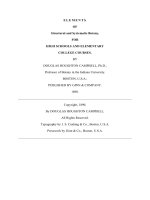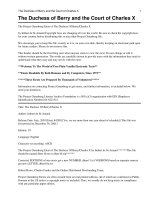Elements of forecasting francis x diebold
Bạn đang xem bản rút gọn của tài liệu. Xem và tải ngay bản đầy đủ của tài liệu tại đây (14.06 MB, 748 trang )
Elements of Forecasting
Francis X. Diebold
University of Pennsylvania
Copyright © F.X. Diebold. All rights reserved.
Fcst4-00-2
To Lawrence Klein, Marc Nerlove and Peter Pauly,
who taught me forecasting.
Copyright © F.X. Diebold. All rights reserved.
Fcst4-00-3
Preface
Most good texts arise from the desire to leave one's stamp on a discipline by training
future generations of students, coupled with the recognition that existing texts are inadequate in
various respects. My motivation is no different.
There is a real need for a concise and modern introductory forecasting text. A number of
features distinguish this book. First, although it uses only elementary mathematics, it conveys a
strong feel for the important advances made since the work of Box and Jenkins more than thirty
years ago. In addition to standard models of trend, seasonality, and cycles, it touches –
sometimes extensively – upon topics such as:
data mining and in-sample overfitting
statistical graphics and exploratory data analysis
model selection criteria
recursive techniques for diagnosing structural change
nonlinear models, including neural networks
regime-switching models
unit roots and stochastic trends
smoothing techniques in their relation to stochastic-trend unobserved-components models
vector autoregressions
cointegration and error correction
predictive causality
forecast evaluation and combination
Copyright © F.X. Diebold. All rights reserved.
Fcst4-00-4
simulation and simulation-based methods
volatility measurement, modeling and forecasting.
Much of that material appears in the "Exercises, Problems and Complements" following each
chapter, which form an integral part of the book. The Exercises, Problems and Complements are
organized so that instructors and students can pick and choose according to their backgrounds
and interests.
Second, the book does not attempt to be exhaustive in coverage. In fact, the coverage is
intentionally selective, focusing on the core techniques with the widest applicability. The book is
designed so that it can be covered realistically in a one-semester course. Core material appears in
the main text, and additional material that expands on the depth and breadth of coverage is
provided in the Exercises, Problems and Complements, as well as the Bibliographical and
Computational Notes, at the end of each chapter.
Third, the book is applications-oriented. It illustrates all methods with detailed real-world
applications designed to mimic typical forecasting situations. In many chapters, the application is
the centerpiece of the presentation. In various places, it uses applications not simply to illustrate
the methods but also to drive home an important lesson, the limitations of forecasting, by
presenting truly realistic examples in which not everything works perfectly!
Fourth, the book is in touch with modern modeling and forecasting software. It uses
Eviews, which is a good modern computing environment for forecasting, throughout. Many of
the data and Eviews programs used in the book are provided on the book’s web page. At the
same time, I am not a software salesman, so the discussion is not wed to any particular software.
Copyright © F.X. Diebold. All rights reserved.
Fcst4-00-5
Students and instructors can use whatever computing environment they like best.
The book has found wide use among students in a variety of fields, including business,
finance, economics, public policy, statistics, and even engineering. The book is directly accessible
at the undergraduate and master's levels; the only prerequisite is an introductory statistics course
that includes linear regression. To help refresh students’ memories, Chapter 2 reviews linear
regression from a forecasting perspective. The book is also of interest to those with more
advanced preparation, because of the hard-to-find direct focus on forecasting (as opposed, for
example, to general statistics, econometrics, or time series analysis). I have used it successfully
for many years as the primary text in my undergraduate forecasting course, as a background text
for various other undergraduate and graduate courses, and as the primary text for master's-level
Executive Education courses given to professionals in business, finance, economics and
government.
Many people have contributed to the development of this book -- some explicitly, some
without knowing it. One way or another, all of the following deserve thanks:
Joan B. Anderon
University of San Diego
Scott Armstrong
University of Pennsylvania
Alan Auerbach
University of California, Berkeley
David Bivin
Indiana University - Purdue University at Indianapolis
Gregory A. Charles
Oregon Health & Science University
Chris Chatfield
University of Bath
Jen-Chi Cheng
Wichita State University
Copyright © F.X. Diebold. All rights reserved.
Fcst4-00-6
Sidhartha Chib
Washington University in St. Louis
Peter Christoffersen
McGill University
Joerg Clostermann
University of Applied Sciences, Fachhochschule Ingolstadt
Dean Croushore
Federal Reserve Bank of Philadelphia
Robert A. Dickler
IMADEC University
Tom Doan
Estima
Michael Donihue
Colby College
Jeffrey Edwards
Texas Tech University
Robert F. Engle
University of California, San Diego
Farzad Farsio
Montana State University, Billings
Robert Fildes
University of Lancaster
Antonio Garcia-Ferrer
Universidad Autonoma de Madrid
Jean-Marie DuFour
University of Montreal
Jessica Gamburg
Heitman
Patrick A. Gaughan
Farleigh-Dickenson University
Clive Granger
University of California, San Diego
Craig Hakkio
Federal Reserve Bank of Kansas City
Eric Hillebrand
Louisiana State University
Eric C. Howe
University of Saskatchewan
Der An Hsu
University of Wisconsin, Milwaukee
Lawrence R. Klein
University of Pennsylvania
Copyright © F.X. Diebold. All rights reserved.
Fcst4-00-7
James Kozik
SPSS, Inc.
Junsoo Lee
University of Alabama
Tae-Hwy Lee
University of California, Riverside
David Lilien
University of California, Irvine
Jose Lopez
Federal Reserve Bank of New York
Ron Michener
University of Virginia
Ray Nelson
Brigham Young University
Caitlin O’Neil
Goldman, Sachs & Co.
Llad Phillips
University of California, Santa Barbara
W. Robert Reed
University of Oklahoma
Russell Robins
Tulane University
Glenn D. Rudebusch
Federal Reserve Bank of San Francisco
Philip Rothman
East Carolina University
Robert Rycroft
Mary Washington College
Richard Saba
Auburn University
Steven Shwiff
Texas A&M University - Commerce
John H. Shannon
Royal Melbourne Institute of Technology
Gokce Soydemir
University of Texas, PanAmerican
Robert Stine
University of Pennsylvania
James H. Stock
Harvard University
Mark Strazicich
University of Central Florida
Copyright © F.X. Diebold. All rights reserved.
Fcst4-00-8
Norman Swanson
Texas A&M University
Hirokuni Tamura
University of Washington
George Tavlas
Bank of Greece
Hiroki Tsurumi
Rutgers University
William Veloce
Brock University
Mark W. Watson
Princeton University
Barry Weller
Penn State University, Erie
Kenneth D. West
University of Wisconsin
Koichi Yoshimine
University of British Columbia
Toshiyuki Yuasa
University of Houston
Tao Zha
Federal Reserve Bank of Atlanta
I am especially grateful to all members of the South-Western team, past and present, including
Jennifer Baker, Jack Calhoun, Dennis Hanseman, Leslie Kauffman and Michael Worls, without
whose encouragement and guidance this book would not have been written. I am similarly
grateful to the many energetic undergraduate and graduate student assistants that I have had over
the years, who read and improved much of the manuscript, including Boragan Aruoba, Adam
Buresh, Morris Davis, Atsushi Inoue, John Schindler, Chiara Scotti, Eric Schwartz, Georg
Strasser, Anthony Tay, Karen Toll and Ginger Wu.
Finally, I apologize and accept full responsibility for the many errors and shortcomings
that undoubtedly remain – minor and major – despite ongoing efforts to eliminate them.
Copyright © F.X. Diebold. All rights reserved.
Fcst4-00-9
Notes to the Fourth Edition
The fourth edition maintains the emphasis of earlier editions on providing an intuitive
building-block approach to the development of modern and practical methods for producing,
evaluating and combining forecasts. Within that framework, several improvements have been
implemented, including:
(1) Enhanced and extended discussion of the elements of probability and statistics of
maximal relevance to forecasting, now included as a separate Chapter 2,
(2) Many new exercises, problems and complements, which emphasize practical
implementation of the methods developed in the text, including simple drills to
check understanding,
(3) Selectively reworked and/or rearranged material, to maximize clarity and pedagogical
effectiveness.
Throughout, my intent has been to insert and delete where needed, sparingly, avoiding the
temptation to fix parts “that ain’t broke.” Hopefully I have moved forward.
F.X.D.
August 2006
Copyright © F.X. Diebold. All rights reserved.
Fcst4-00-10
About the Author
FRANCIS X. DIEBOLD is W.P. Carey Professor of Economics, and Professor of Finance and
Statistics, at the University of Pennsylvania and its Wharton School, and a Research Associate at
the National Bureau of Economic Research in Cambridge, Mass. A leader in forecasting and
modeling in business, economics and finance, Diebold has published widely and served on
numerous editorial boards, including Econometrica and Review of Economics and Statistics. He
is an elected Fellow of the Econometric Society and the American Statistical Association, and the
recipient of Sloan, Guggenheim, and Humboldt awards. A prize-winning teacher and popular
lecturer, he lectures worldwide and has held visiting appointments in finance and economics at
Princeton University, the University of Chicago, Cambridge University, Johns Hopkins University,
and New York University. Diebold also has extensive experience in corporate and policy
environments; he is consulted regularly by leading financial firms, central banks, and policy
organizations, and he has served on a variety of advisory and corporate boards. From 1986-1989
he served as an economist at the Federal Reserve Board in Washington DC, working first with
Paul Volcker and then with Alan Greenspan. You can find him on the web at
www.ssc.upenn.edu/~fdiebold.
Copyright © F.X. Diebold. All rights reserved.
Fcst4-00-11
Table of Contents
Part I
Getting Started
1. Introduction to Forecasting: Applications, Methods, Books, Journals and Software
Forecasting in action
Forecasting methods: an overview of the book
Useful books, journals, software and online information
Looking ahead
Exercises, Problems and complements
Forecasting in daily life: we all forecast, all the time
Forecasting in business, finance, economics and government
The basic forecasting framework
Degrees of forecastability
Data on the web
Univariate and multivariate forecasting models
Bibliographical and computational notes
Concepts for review
References and additional readings
2. A Brief Review of Probability, Statistics, and Regression for Forecasting
Why this chapter?
Random variables, distributions and moments
Multivariate random variables
Statistics
Regression analysis
Exercises, Problems and complements
Interpreting distributions and densities
Covariance and correlation
Copyright © F.X. Diebold. All rights reserved.
Fcst4-00-12
Conditional expectations vs. linear projections
Conditional mean and variance
Scatter plots and regression lines
Desired values of regression diagnostic statistics
Mechanics of fitting a linear regression
Regression with and without a constant term
Interpreting coefficients and variables
Nonlinear least squares
Regression semantics
Bibliographical and computational notes
Concepts for review
3. Six Considerations Basic to Successful Forecasting
The decision environment and loss function
The forecast object
The forecast statement
The forecast horizon
The information set
Methods and complexity, the parsimony principle, and the shrinkage principle
Concluding remarks
Exercises, Problems and complements
Data and forecast timing conventions
Properties of loss functions
Relationships among point, interval and density forecasts
Forecasting at short through long horizons
Forecasting as an ongoing process in organizations
Assessing forecasting situations
Bibliographical and computational notes
Concepts for review
Copyright © F.X. Diebold. All rights reserved.
Fcst4-00-13
References and additional readings
Part II
Building, Using and Evaluating Forecasting Models
4. Statistical Graphics for Forecasting
The power of statistical graphics
Simple graphical techniques
Elements of graphical style
Application: graphing four components of real GDP
Exercises, Problems and complements
Outliers
Simple vs. partial correlation
Graphical regression diagnostic I: time series plot of
Graphical regression diagnostic II: time series plot of
or
Graphical regression diagnostic III: scatterplot of
Graphical analysis of foreign exchange rate data
Common scales
Graphing real GDP, continued
Color
Regression, regression diagnostics, and regression graphics in action
Bibliographical and computational notes
Concepts for review
References and additional readings
5. Modeling and Forecasting Trend
Modeling trend
Estimating trend models
Forecasting trend
Copyright © F.X. Diebold. All rights reserved.
Fcst4-00-14
Selecting forecasting models using the Akaike and Schwarz criteria
Application: forecasting retail sales
Exercises, Problems and complements
Calculating forecasts from trend models
Specifying and testing trend models
Understanding model selection criteria
Mechanics of trend estimation and forecasting
Properties of polynomial trends
Specialized nonlinear trends
Moving-average smoothing for trend estimation
Bias corrections when forecasting from logarithmic models
Model selection for long-horizon forecasting
The variety of “information criteria” reported across software packages
Bibliographical and computational notes
Concepts for review
References and additional readings
6. Modeling and Forecasting Seasonality
The nature and sources of seasonality
Modeling seasonality
Forecasting seasonal series
Recursive estimation procedures for diagnosing and selecting forecasting models
Application: forecasting housing starts
Exercises, Problems and complements
Log transformations in seasonal models
Seasonal adjustment
Selecting forecasting models involving calendar effects
Testing for seasonality
Seasonal regressions with an intercept and s-1 seasonal dummies
Copyright © F.X. Diebold. All rights reserved.
Fcst4-00-15
Applied trend and seasonal modeling
Periodic models
Interpreting dummy variables
Constructing seasonal models
Calendar effects
Bibliographical and computational notes
Concepts for review
References and additional readings
7. Characterizing Cycles
Covariance stationary time series
White noise
The lag operator
Wold’s theorem, the general linear process, and rational distributed lags
Estimation and inference for the mean, autocorrelation and partial autocorrelation
functions
Application: characterizing Canadian employment dynamics
Exercises, Problems and complements
Lag operators I
Lag operators II
Autocorrelation functions of covariance stationary time series
Conditional and unconditional means
White noise residuals
Selecting an employment forecasting model with the AIC and SIC
Simulating time series processes
Sample autocorrelation functions for trending series
Sample autocorrelation functions for seasonal series
Volatility dynamics: correlograms of squares
Bibliographical and computational notes
Copyright © F.X. Diebold. All rights reserved.
Fcst4-00-16
Concepts for review
References and additional readings
8. Modeling Cycles: MA, AR and ARMA Models
Moving-average (MA) models
Autoregressive (AR) models
Autoregressive moving average (ARMA) models
Application: specifying and estimating models for employment forecasting
Exercises, Problems and complements
ARMA lag inclusion
Shapes of correlograms
The autocovariance function of the MA(1) process, revisited
ARMA algebra
Diagnostic checking of model residuals
The mechanics of fitting ARMA models
Modeling cyclical dynamics
Aggregation and disaggregation: top-down vs. bottom-up forecasting models
Nonlinear forecasting models: regime switching
Difficulties with nonlinear optimization
Bibliographical and computational notes
Concepts for review
References and additional readings
9. Forecasting Cycles
Optimal forecasts
Forecasting moving average processes
Making the forecasts operational
The chain rule of forecasting
Application: forecasting employment
Exercises, Problems and complements
Copyright © F.X. Diebold. All rights reserved.
Fcst4-00-17
Forecast accuracy across horizons
Mechanics of forecasting with ARMA models: BankWire continued
Forecasting an AR(1) process with known and unknown parameters
Forecasting an ARMA(2,2) process
Optimal forecasting under asymmetric loss
Truncation of infinite distributed lags, state-space representations, and the Kalman
filter
Point and interval forecasts allowing for serial correlation - Nile.com continued
Bootstrap simulation to acknowledge innovation distribution uncertainty and
parameter estimation uncertainty
Bibliographical and computational notes
Concepts for review
References and additional readings
10. Putting it all Together: A Forecasting Model with Trend, Seasonal and Cyclical Components
Assembling what we've learned
Application: forecasting liquor sales
Recursive estimation procedures for diagnosing and selecting forecasting models
Liquor sales, continued
Exercises, Problems and complements
Serially correlated disturbances vs. lagged dependent variables
Assessing the adequacy of the liquor sales forecasting model trend specification
Improving non-trend aspects of the liquor sales forecasting model
CUSUM analysis of the housing starts model
Model selection based on simulated forecasting performance
Seasonal models with time-varying parameters: forecasting AirSpeed passengermiles
Formal models of unobserved components
The restrictions associated with unobserved-components structures
Copyright © F.X. Diebold. All rights reserved.
Fcst4-00-18
Additive and multiplicative unobserved-components decompositions
Signal, noise, and overfitting
Bibliographical and computational notes
Concepts for review
References and additional readings
11. Forecasting with Regression Models
Conditional forecasting models and scenario analysis
Accounting for parameter uncertainty in confidence intervals for conditional forecasts
Unconditional forecasting models
Distributed lags, polynomial distributed lags, and rational distributed lags
Regressions with lagged dependent variables, regressions with ARMA disturbances, and
transfer function models
Vector autoregressions
Predictive causality
Impulse-response functions and variance decompositions
Application: housing starts and completions
Exercises, Problems and complements
Econometrics, time series analysis, and forecasting
Forecasting crop yields
Regression forecasting models with expectations, or anticipatory, data
Business cycle analysis and forecasting: expansions, contractions, turning points,
and leading indicators
Subjective information, Bayesian VARs, and the Minnesota prior
Housing starts and completions, continued
Nonlinear regression models I: functional form and Ramsey's test
Nonlinear regression models II: logarithmic regression models
Nonlinear regression models III: neural networks
Spurious regression
Copyright © F.X. Diebold. All rights reserved.
Fcst4-00-19
Comparative forecasting performance of VAR and univariate models
Bibliographical and computational notes
Concepts for review
References and additional readings
12. Evaluating and Combining Forecasts
Evaluating a single forecast
Evaluating two or more forecasts: comparing forecast accuracy
Forecast encompassing and forecast combination
Application: OverSea shipping volume on the Atlantic East trade lane
Exercises, Problems and complements
Forecast evaluation in action
Forecast error analysis
Combining forecasts
Quantitative forecasting, judgmental forecasting, forecast combination, and
shrinkage
The algebra of forecast combination
The mechanics of practical forecast evaluation and combination
What are we forecasting? Preliminary series, revised series, and the limits to
forecast accuracy
Ex post vs. real-time forecast evaluation
What do we know about the accuracy of macroeconomic forecasts?
Forecast evaluation when realizations are unobserved
Forecast error variances in models with estimated parameters
The empirical success of forecast combination
Forecast combination and the Box-Jenkins paradigm
Consensus forecasts
The Delphi method for combining experts' forecasts
Bibliographical and computational notes
Copyright © F.X. Diebold. All rights reserved.
Fcst4-00-20
Concepts for review
References and additional readings
Part III
More Advanced Topics
13. Unit Roots, Stochastic Trends, ARIMA Forecasting Models, and Smoothing
Stochastic trends and forecasting
Unit roots: estimation and testing
Application: modeling and forecasting the yen/dollar exchange rate
Smoothing
Exchange rates, continued
Exercises, Problems and complements
Modeling and forecasting the deutschemark/dollar exchange rate
Automatic ARIMA modeling
The multiplicative seasonal ARIMA (p,d,q) x (P,D,Q) model
The Dickey-Fuller regression in the AR(2) case
ARIMA models, smoothers, and shrinkage
Holt-Winters smoothing with multiplicative seasonality
Using stochastic-trend unobserved-components models to implement smoothing
techniques in a probabilistic framework
Volatility dynamics and exponential smoothing of squares
Housing starts and completions, continued
Cointegration
Error Correction
Forecast encompassing tests for I(1) series
Evaluating forecasts of integrated series
Theil’s U-Statistic
Bibliographical and computational notes
Copyright © F.X. Diebold. All rights reserved.
Fcst4-00-21
Concepts for review
References and additional readings
14. Volatility Measurement, Modeling and Forecasting
The basic ARCH process
The GARCH process
Extensions of ARCH and GARCH models
Estimating, forecasting and diagnosing GARCH models
Application: stock market volatility
Exercises, Problems and complements
Removing conditional mean dynamics before modeling volatility dynamics
Variations on the basic ARCH and GARCH models
Empirical performance of pure ARCH models as approximations to volatility
dynamics
Direct modeling of volatility proxies
GARCH volatility forecasting
Assessing volatility dynamics in observed returns and in standardized returns
Allowing for leptokurtic conditional densities
Optimal prediction under asymmetric loss
Multivariate GARCH models
Bibliographical and computational notes
Concepts for review
References and additional readings
Bibliography
Name Index
Subject Index
Copyright © F.X. Diebold. All rights reserved.
Chapter 1
Introduction to Forecasting:
Applications, Methods, Books, Journals and Software
Forecasting is important – forecasts are constantly made in business, finance, economics,
government, and many other fields, and much depends upon them. As with anything else, there
are good and bad ways to forecast. This book is about the good ways – modern, quantitative,
statistical/econometric methods of producing and evaluating forecasts.
1. Forecasting in Action
Forecasts are made to guide decisions in a variety of fields. To develop a feel for the
tremendous diversity of forecasting applications, let’s sketch some of the areas where forecasts
are used, and the corresponding diversity of decisions aided by forecasts.
a. Operations planning and control. Firms routinely forecast sales to help guide decisions in
inventory management, sales force management, and production planning, as well as
strategic planning regarding product lines, new market entry, and so on. Firms use
forecasts to decide what to produce (What product or mix of products should be
produced?), when to produce (Should we build up inventories now in anticipation of high
future demand? How many shifts should be run?), how much to produce and how much
capacity to build (What are the trends in market size and market share? Are there cyclical
or seasonal effects? How quickly and with what pattern will a newly-built plant or a
newly-installed technology depreciate?), and where to produce (Should we have one plant
or many? If many, where should we locate them?). Firms also use forecasts of future
prices and availability of inputs to guide production decisions.
Copyright © F.X. Diebold. All rights reserved.
Fcst4-01-2
b. Marketing. Forecasting plays a key role in many marketing decisions. Pricing decisions,
distribution path decisions, and advertising expenditure decisions all rely heavily on
forecasts of responses of sales to different marketing schemes.
c. Economics. Governments, policy organizations, and private forecasting firms around the
world routinely forecast the major economic variables, such as gross domestic product
(GDP), unemployment, consumption, investment, the price level, and interest rates.
Governments use such forecasts to guide monetary and fiscal policy, and private firms use
them for strategic planning, because economy-wide economic fluctuations typically have
industry-level and firm-level effects. In addition to forecasting “standard” variables such
as GDP, economists sometimes make more exotic forecasts, such as the stage of the
business cycle that we'll be in six months from now (expansion or contraction), the state of
future stock market activity (bull or bear), or the state of future foreign exchange market
activity (appreciation or depreciation). Again, such forecasts are of obvious use to both
governments and firms -- if they’re accurate!
d. Financial asset management. Portfolio managers have an interest in forecasting asset returns
(stock returns, interest rates, exchange rates, and commodity prices) and such forecasts
are made routinely. There is endless debate about the success of forecasts of asset returns.
On the one hand, asset returns should be very hard to forecast; if they were easy to
forecast, you could make a fortune easily, and any such “get rich quick” opportunities
should already have been exploited. On the other hand, those who exploited them along
the way may well have gotten rich! Thus, we expect that simple, widely-available
Copyright © F.X. Diebold. All rights reserved.
Fcst4-01-3
methods for forecasting should have little success in financial markets, but there may well
be profits to be made from using new and sophisticated techniques to uncover and exploit
previously-unnoticed patterns in financial data (at least for a short time, until other market
participants catch on or your own trading moves the market).
e. Financial risk management. The forecasting of asset return volatility is related to the
forecasting of asset returns. In the last ten years, practical methods for volatility
forecasting have been developed and widely applied. Volatility forecasts are crucial for
evaluating and insuring risks associated with asset portfolios. Volatility forecasts are also
crucial for firms and investors who need to price assets such as options and other
derivatives.
f. Business and government budgeting. Businesses and governments of all sorts must constantly
plan and justify their expenditures. A major component of the budgeting process is the
revenue forecast. Large parts of firms’ revenues typically come from sales, and large parts
of governments’ revenues typically come from tax receipts, both of which exhibit cyclical
and long-term variation.
g. Demography. Demographers routinely forecast the populations of countries and regions all
over the world, often in disaggregated form, such as by age, sex, and race. Population
forecasts are crucial for planning government expenditure on health care, infrastructure,
social insurance, anti-poverty programs, and so forth. Many private-sector decisions, such
as strategic product line decisions by businesses, are guided by demographic forecasts of
particular targeted population subgroups. Population in turn depends on births, deaths,
Copyright © F.X. Diebold. All rights reserved.
Fcst4-01-4
immigration and emigration, which are also forecasted routinely.
h. Crisis management. A variety of events corresponding to crises of various sorts are frequently
forecast. Such forecasts are routinely issued as probabilities. For example, in both
consumer and commercial lending, banks generate default probability forecasts and refuse
loans if the probability is deemed too high. Similarly, international investors of various
sorts are concerned with probabilities of default, currency devaluations, military coups,
etc., and use forecasts of such events to inform their portfolio allocation decisions.
The variety of forecasting tasks that we've just sketched was selected to help you begin to
get a feel for the depth and breadth of the field. Surely you can think of many more situations in
which forecasts are made and used to guide decisions.
With so many different forecasting applications, you might think that a huge variety of
forecasting techniques exists, and that you’ll have to master all of them. Fortunately, that's not
the case. Instead, a relatively small number of tools form the common core of almost all
forecasting methods. Needless to say, the details differ if one is forecasting Intel’s stock price one
day and the population of Scotland the next, but the principles underlying the forecasts are
identical. Thus we’ll focus on the underlying core principles, which drive all applications.
2. Forecasting Methods: An Overview of the Book
To give you a broad overview of the forecasting landscape, let’s sketch what’s to follow
in the chapters ahead. If some of the terms and concepts seem unfamiliar, rest assured that we’ll
be studying them in depth in later chapters.
Forecasting is inextricably linked to the building of statistical models. Before we can
Copyright © F.X. Diebold. All rights reserved.









